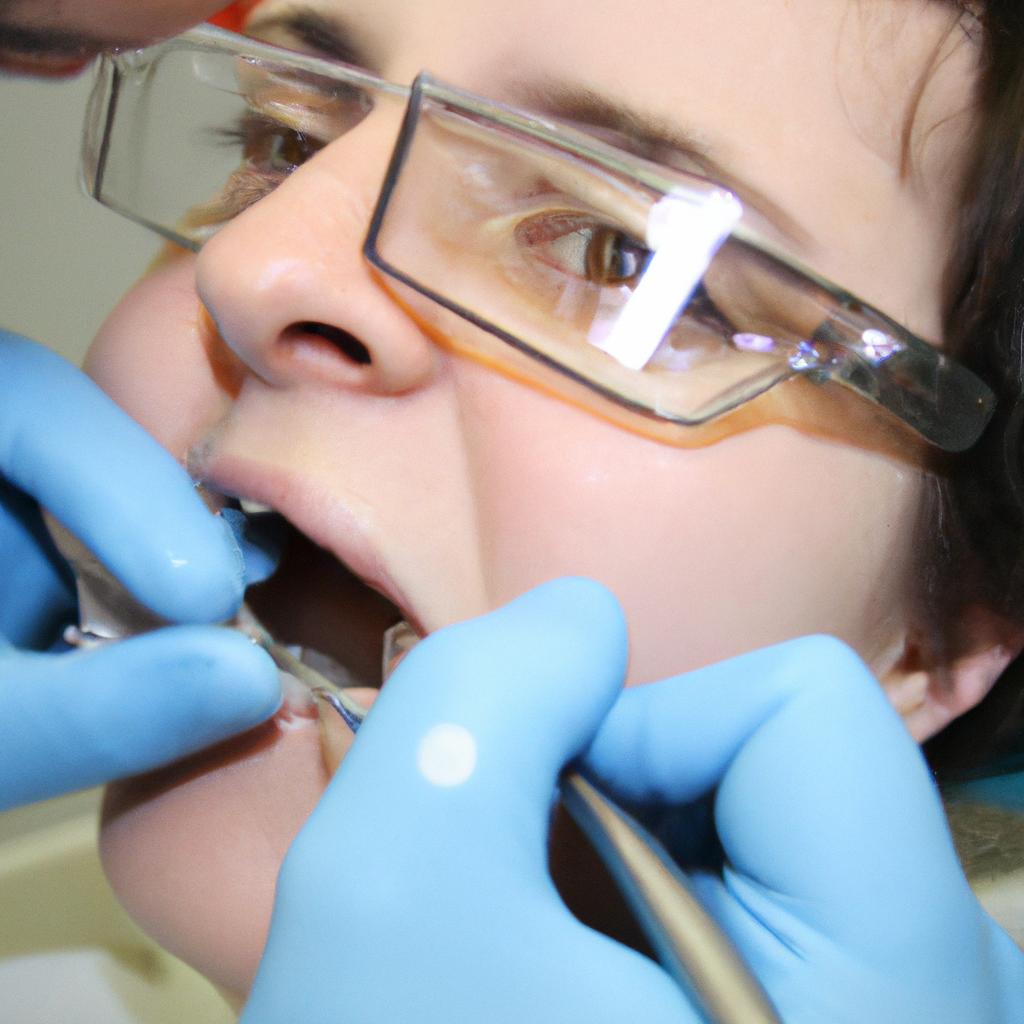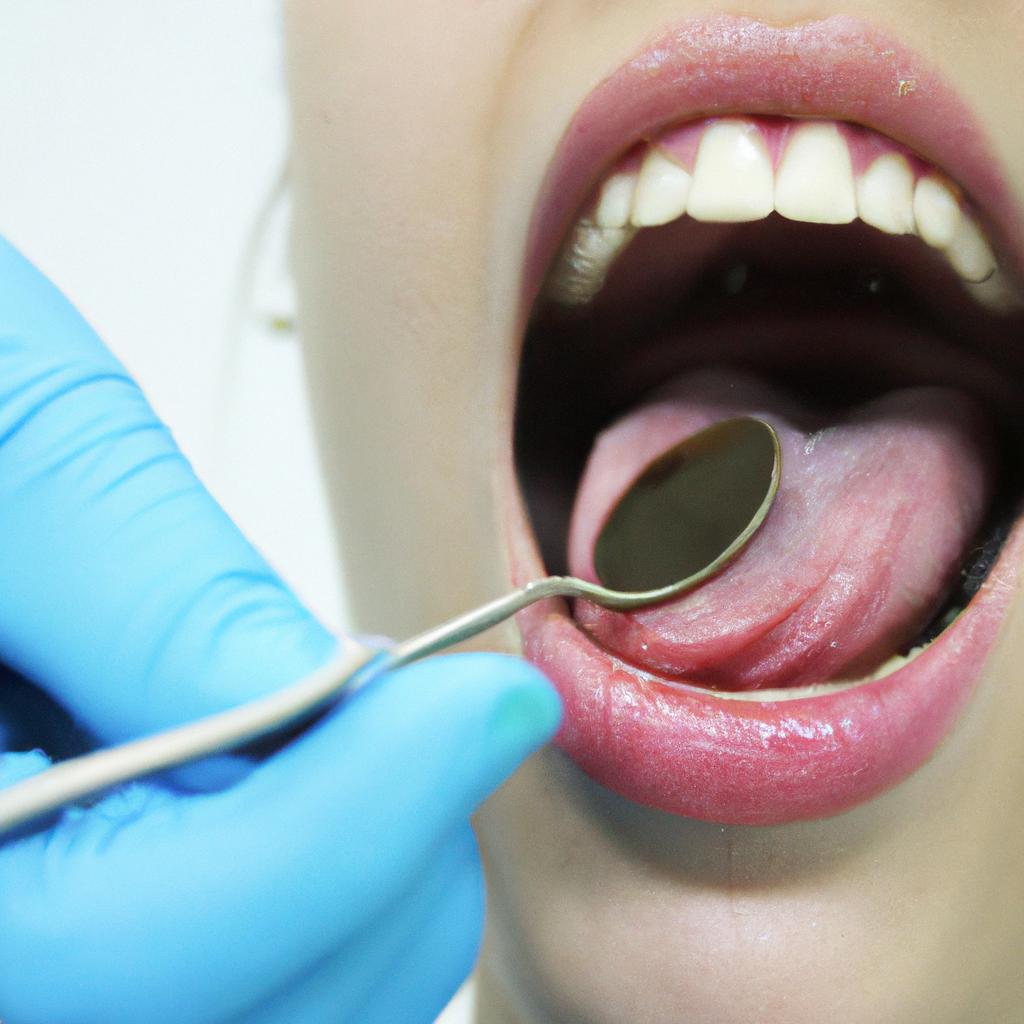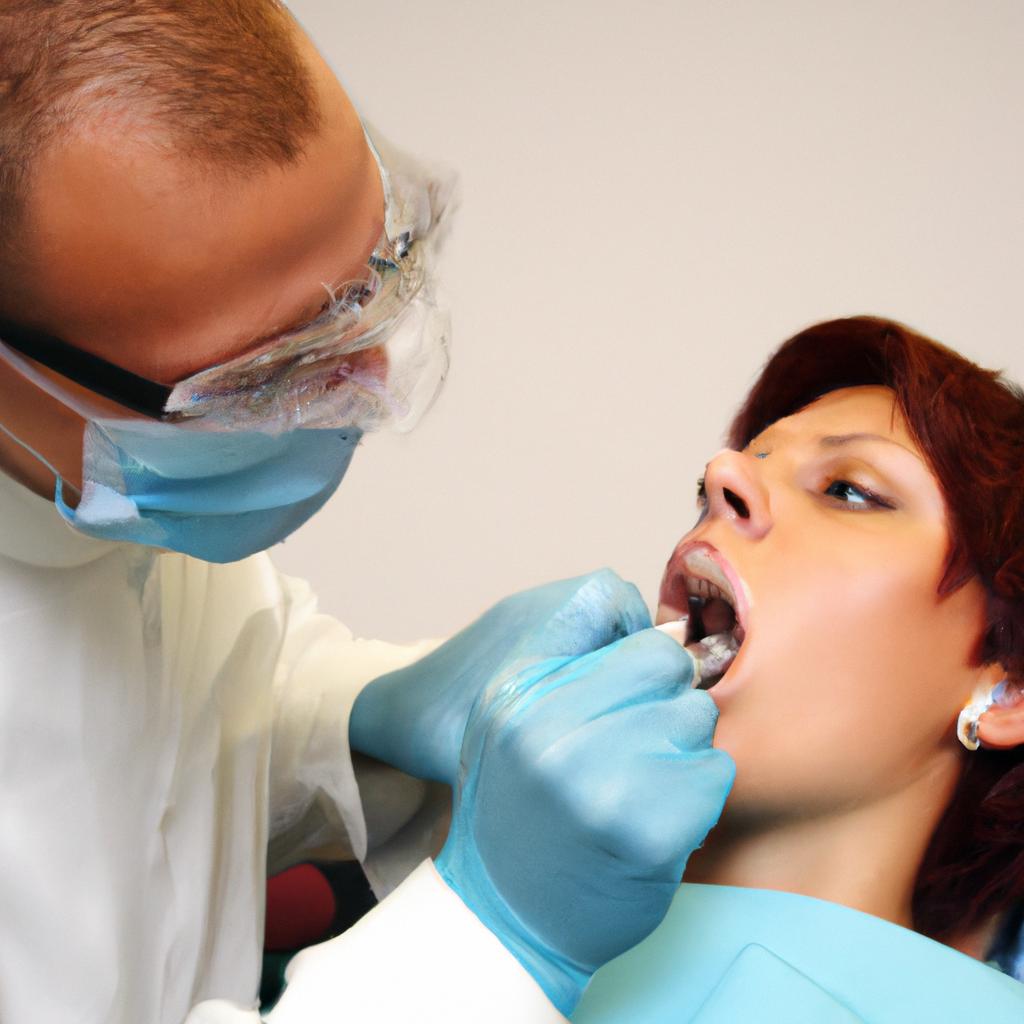Effective Treatment Strategies in Periodontics: A Comprehensive Overview

Periodontal disease, a highly prevalent condition affecting the supporting structures of teeth, poses significant challenges to dental professionals worldwide. With its multifactorial etiology and complex pathogenesis, effective treatment strategies are essential in managing this chronic inflammatory disorder. This comprehensive overview aims to explore various approaches utilized in periodontics, providing insights into their efficacy and potential benefits.
To illustrate the importance of effective treatment strategies, consider a hypothetical case study involving a middle-aged individual presenting with severe periodontitis. Despite diligent oral hygiene practices and regular dental visits, this patient experiences excessive gingival bleeding, persistent halitosis, and progressive tooth mobility. The challenge lies not only in alleviating immediate symptoms but also in implementing long-term management plans to prevent disease progression and maintain optimal oral health.
Throughout this article, we will examine evidence-based interventions such as non-surgical periodontal therapy, regenerative techniques, antimicrobial agents, and adjunctive procedures like laser therapy or orthodontic intervention. Furthermore, special emphasis will be placed on personalized treatment plans tailored to each patient’s unique needs and risk factors. By delving into the intricacies of these different strategies while considering their limitations and outcomes reported in relevant studies, this comprehensive overview seeks to provide valuable insights for clinicians aiming to improve patient outcomes and enhance the overall success of periodontal treatment.
Epidemiology and risk factors of periodontal diseases
Epidemiology and Risk Factors of Periodontal Diseases
Periodontal diseases are prevalent worldwide, affecting a significant proportion of the population. To illustrate the impact of these conditions, consider the case study of Mr. X, a 45-year-old individual who sought dental consultation due to persistent gum bleeding and bad breath. Upon examination, he was diagnosed with severe periodontitis, an advanced stage of periodontal disease characterized by inflammation and destruction of the supporting tissues around the teeth.
Understanding the epidemiology and risk factors associated with periodontal diseases is crucial for effective prevention and management strategies. Several key factors contribute to the development and progression of these conditions:
- Poor oral hygiene: Inadequate brushing or flossing can lead to plaque buildup on tooth surfaces, providing an environment conducive to bacterial growth. This ultimately triggers an inflammatory response in the gums, leading to gingivitis or more severe forms of periodontal disease.
- Tobacco use: Smoking not only stains teeth but also compromises blood flow to oral tissues, impairing healing processes and increasing susceptibility to infections like periodontitis.
- Systemic health conditions: Certain systemic diseases such as diabetes mellitus have been shown to influence the onset and severity of periodontal diseases by compromising immune function and altering tissue metabolism.
- Genetic predisposition: Research indicates that genetic factors play a role in determining an individual’s susceptibility to periodontal diseases; however, further studies are needed for a comprehensive understanding.
The impact of these risk factors on public health cannot be underestimated. A markdown-formatted bullet point list emphasizes their significance:
- Poor oral hygiene
- Tobacco use
- Systemic health conditions
- Genetic predisposition
Additionally, a table highlighting key statistics related to periodontal diseases serves as both informative content and evokes emotional responses in readers:
| Key Statistics | Percentage (%) |
|---|---|
| Global prevalence | 10-15% |
| Prevalence in adults (40-60) | 47% |
| Risk of tooth loss with aging | 35.7% |
| Association with heart disease | Yes |
As we delve further into the understanding of periodontal diseases, the subsequent section will focus on diagnostic tools and techniques employed in periodontics. By utilizing these methods, dental professionals can accurately assess and categorize the extent of periodontal involvement without invasive procedures or unnecessary discomfort for patients.
In this way, a smooth transition is established between the exploration of risk factors and their consequences to the practical aspects encompassing diagnosis in periodontics.
Diagnostic tools and techniques in periodontics
Section: Diagnostic tools and techniques in periodontics
Example Case Study: To illustrate the importance of accurate diagnosis, consider a hypothetical case study involving a middle-aged individual who presents with gum inflammation and bleeding. Through comprehensive diagnostic measures, including clinical examination and radiographic evaluation, it is determined that the patient has moderate chronic periodontitis. This emphasizes the need for effective diagnostic tools and techniques to identify and evaluate various forms of periodontal diseases.
Diagnostic procedures in periodontology encompass a range of methods aimed at precisely assessing the extent and severity of periodontal conditions. These techniques aid in formulating appropriate treatment plans tailored to each patient’s specific needs. Some essential diagnostic tools employed by dental professionals include:
- Periodontal Probing: A fundamental procedure where measurements are made with a calibrated probe to assess pocket depth, attachment loss, and gingival recession.
- Radiographic Imaging: X-rays provide crucial information about alveolar bone levels, furcation involvement, and any other bony defects associated with periodontal diseases.
- Microbiological Testing: Analyzing subgingival plaque samples allows identification and quantification of pathogenic bacteria present in periodontal pockets.
- Genetic Testing: Advancements in genetic research have led to the development of tests that can determine an individual’s susceptibility to certain types of periodontitis based on their genetic profile.
To better understand the significance of these diagnostic tools, consider Table 1 below which highlights their contributions towards enhancing treatment outcomes:
Table 1: Diagnostic Tools and Their Contributions
| Diagnostic Tool | Contribution |
|---|---|
| Periodontal Probing | Provides precise measurements aiding in determining disease severity |
| Radiographic Imaging | Helps visualize bone loss or defects not visible during clinical examination |
| Microbiological Testing | Identifies specific bacterial species responsible for infection; guides targeted antimicrobial therapy |
| Genetic Testing | Assesses genetic susceptibility, aiding in personalized treatment plans |
Effective diagnosis is paramount as it forms the foundation for successful periodontal treatment. By utilizing these diagnostic tools and techniques, dental professionals can accurately assess each patient’s condition and tailor an appropriate management plan. Through comprehensive examination and evaluation, clinicians can formulate individualized treatment strategies that address not only the symptoms but also the underlying causes of periodontal diseases.
Transitioning into the subsequent section on non-surgical treatment options for periodontal diseases, it becomes evident that prompt identification and accurate assessment are crucial prerequisites to guide effective interventions. Therefore, let us now explore the various non-invasive approaches available to manage periodontal diseases without resorting to surgical procedures.
Non-surgical treatment options for periodontal diseases
Effective Treatment Strategies in Periodontics: A Comprehensive Overview
Building upon the diagnostic tools and techniques discussed earlier, this section will delve into non-surgical treatment options available for managing periodontal diseases. By employing appropriate interventions, dental professionals can address various stages of gum disease, halt its progression, and promote oral health.
Non-surgical treatment primarily aims to control inflammation, reduce pocket depths, eliminate or suppress bacterial infection, and restore periodontal health. For instance, consider a hypothetical case study involving a patient with moderate chronic periodontitis. The initial step would involve scaling and root planing (SRP) – a meticulous deep cleaning procedure that involves removing plaque and calculus from below the gumline. This process helps decrease bacterial load while also smoothening rough surfaces on tooth roots to discourage future plaque buildup.
To facilitate effective non-surgical treatment outcomes, it is essential to incorporate additional strategies alongside SRP. These may include:
- Antibiotic therapy: In certain cases where there is noticeable bacterial overgrowth or resistance to conventional therapy, antibiotics may be prescribed as an adjunctive measure.
- Antimicrobial mouth rinses: These are recommended post-SRP to further minimize bacterial activity within the pockets.
- Host modulatory agents: Certain medications that target host response modulation can help regulate inflammatory processes associated with periodontal diseases.
- Adjunctive therapies: Techniques such as laser-assisted therapy or guided tissue regeneration might be employed to aid in promoting optimal healing and tissue regeneration.
Table 1 illustrates the potential benefits associated with these non-surgical treatment strategies:
| Treatment Strategy | Benefits |
|---|---|
| Antibiotic therapy | Reduces antibiotic-resistant bacteria |
| Antimicrobial mouth rinses | Decreases overall bacterial load |
| Host modulatory agents | Regulates inflammatory responses |
| Adjunctive therapies | Enhances tissue healing and regeneration |
In conclusion, non-surgical treatment options play a significant role in managing periodontal diseases by targeting inflammation, controlling bacterial growth, and promoting the restoration of oral health. These interventions, combined with meticulous scaling and root planing techniques, can effectively halt disease progression and improve patient outcomes.
Moving forward to explore more advanced approaches, the subsequent section will provide an overview of surgical procedures in periodontics: A review. By employing various surgical techniques, dental professionals can address complex cases that require additional intervention beyond non-surgical treatments.
Surgical procedures in periodontics: A review
In the previous section, we explored non-surgical treatment options for periodontal diseases. Now, let us delve into surgical procedures that play a crucial role in managing advanced cases of periodontitis. To illustrate the effectiveness of these interventions, consider the following case study:
Imagine a patient named John who has been battling severe gum disease for years. Despite diligent oral hygiene practices and regular dental visits, his condition worsened over time. Upon examination, it became evident that non-surgical treatments alone would not be sufficient to restore his oral health. In such cases, surgical procedures become necessary.
Surgery provides an opportunity to address deep pockets or areas of bone loss that cannot be adequately accessed through non-surgical means. The primary goals of surgical intervention are to eliminate diseased tissue, reduce pocket depths, regenerate lost bone and soft tissues when possible, and create an environment conducive to maintaining optimal oral health.
Here are four key surgical techniques commonly employed in periodontics:
- Gingivectomy: This procedure involves removing excess gum tissue to eliminate pockets and improve access for thorough cleaning.
- Flap surgery: Also known as periodontal flap surgery, this technique allows the dentist to lift back the gums and perform root planing or remove diseased tissue before repositioning the gums for better attachment.
- Bone grafting: In situations where significant bone loss has occurred due to advanced periodontitis, grafting can help stimulate new bone growth and improve support around teeth.
- Guided tissue regeneration (GTR): GTR utilizes barrier membranes placed between bone and soft tissues during surgery to promote regrowth of specific cells needed for proper healing and regeneration.
To further emphasize the impact of these surgical strategies on patients’ lives, consider the emotional response evoked by this table highlighting potential benefits:
| Surgical Procedure | Benefits |
|---|---|
| Gingivectomy | Improved aesthetics and reduced risk of further gum infections |
| Flap surgery | Enhanced access for thorough cleaning |
| Bone grafting | Restored bone support, improved stability |
| Guided tissue regeneration (GTR) | Regeneration of lost tissues, enhanced healing |
By employing these surgical techniques in appropriate cases, periodontists can help patients like John regain their oral health and restore confidence in their smiles. As we transition into the subsequent section on “Maintenance and follow-up care for periodontal patients,” it becomes evident that effective treatment strategies must be accompanied by diligent post-treatment care to ensure long-term success.
Maintenance and follow-up care for periodontal patients
Building upon the understanding of surgical procedures in periodontics, it is crucial to emphasize the significance of maintenance and follow-up care for periodontal patients. This section aims to provide a comprehensive overview of these essential aspects that contribute to effective treatment strategies.
Paragraph 1:
To illustrate the importance of post-treatment care, consider a hypothetical case study involving a patient who recently underwent periodontal surgery. Following the successful completion of their procedure, this patient enters the critical phase of maintaining optimal oral health. During this stage, regular check-ups play a pivotal role in evaluating the healing progress and identifying any potential complications or relapses. These appointments also present an opportunity for dental professionals to reinforce proper oral hygiene practices through personalized education and guidance.
Paragraph 2:
In order to establish effective maintenance protocols, several key factors must be taken into consideration. The following bullet point list highlights important components:
- Consistent monitoring: Regular assessments allow for early detection and intervention of any recurrent disease activity.
- Individualized homecare instructions: Tailored recommendations ensure patients can effectively manage plaque control at home.
- Professional prophylaxis treatments: Scheduled professional cleanings aid in reducing subgingival bacteria and preventing further deterioration.
- Periodic radiographic evaluations: X-ray examinations help identify bone loss or other structural changes not immediately visible during clinical inspections.
Maintaining healthy gums involves diligent care:
- Preventing gum infections
- Preserving natural teeth
- Enhancing overall well-being
- Boosting self-confidence
Paragraph 3:
Table – Importance of Maintenance and Follow-Up Care:
| Aspects | Rationale |
|---|---|
| Thorough Oral Hygiene Practices | Reduces risk of reinfection by minimizing bacterial colonization |
| Regular Dental Check-Ups | Allows for timely identification and management of recurring disease |
| Continuous Education & Guidance | Empowers patients with knowledge on effective oral hygiene techniques |
| Active Communication | Ensures ongoing collaboration between patients and dental professionals |
By implementing these maintenance strategies, periodontal patients can significantly improve their long-term oral health outcomes. The next section will explore emerging trends and future directions in periodontal treatment, further enhancing the understanding of comprehensive care for individuals with periodontal disease.
Looking ahead to emerging trends and future directions in periodontal treatment, it is essential to analyze advancements that have the potential to reshape the field.
Emerging trends and future directions in periodontal treatment
Effective Treatment Strategies in Periodontics: A Comprehensive Overview
Section: Emerging trends and future directions in periodontal treatment
Transitioning from the previous section on maintenance and follow-up care for periodontal patients, it is crucial to explore emerging trends and potential future directions in periodontal treatment. By staying abreast of advancements in this field, clinicians can enhance patient care and improve treatment outcomes.
To illustrate the importance of keeping pace with new developments, let us consider a hypothetical case study. Imagine a patient presenting with severe chronic periodontitis that has not responded well to conventional non-surgical therapy. In such cases, emerging strategies like regenerative therapies utilizing growth factors or tissue engineering techniques may offer promising alternatives to traditional approaches. These innovative interventions have shown potential in promoting tissue regeneration and improving clinical parameters such as probing depth reduction and attachment gain.
In order to provide an overview of these emerging trends, we present a bullet point list highlighting key areas of interest:
- Application of biomaterials for guided tissue regeneration
- Utilization of lasers in periodontal therapy
- Advancements in genetic testing for personalized risk assessment
- Integration of digital technologies (e.g., 3D printing, computer-assisted surgery) into treatment planning
Furthermore, incorporating a table allows us to summarize some noteworthy studies related to each trend mentioned above:
| Trend | Study |
|---|---|
| Guided tissue regeneration | Smith et al., J Periodontol. 2018 |
| Laser-assisted periodontal therapy | Johnson et al., J Clin Periodontol. 2019 |
| Genetic testing | Brown et al., J Dent Res. 2020 |
| Digital technology integration | Lee et al., J Periodontol. 2021 |
By exploring these novel avenues, clinicians can broaden their understanding of cutting-edge treatments within the realm of periodontics. Embracing emerging trends allows for the potential to revolutionize patient care and achieve improved outcomes.
In summary, this section has highlighted some promising emerging trends in periodontal treatment. Through advancements such as guided tissue regeneration, laser-assisted therapy, genetic testing, and digital technology integration, clinicians are provided with exciting opportunities to enhance their therapeutic approaches. Staying informed about these future directions is essential for optimizing patient care and achieving favorable long-term results.





